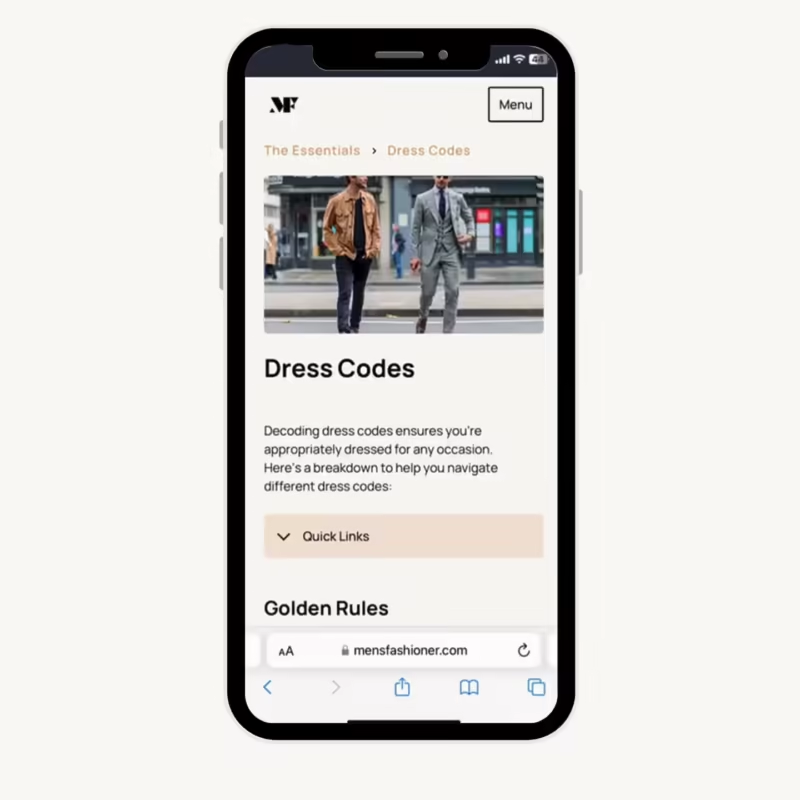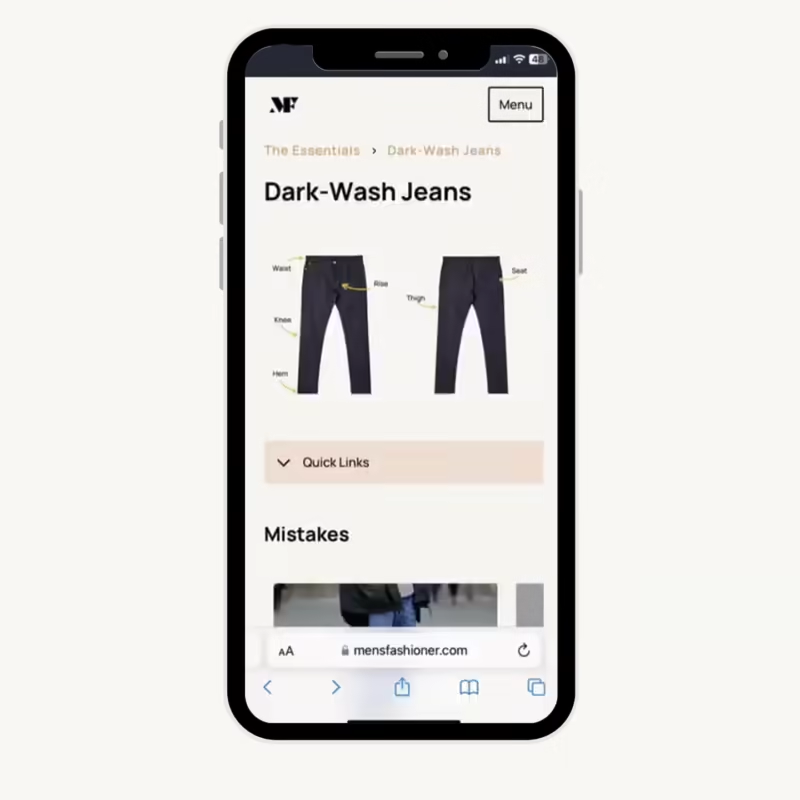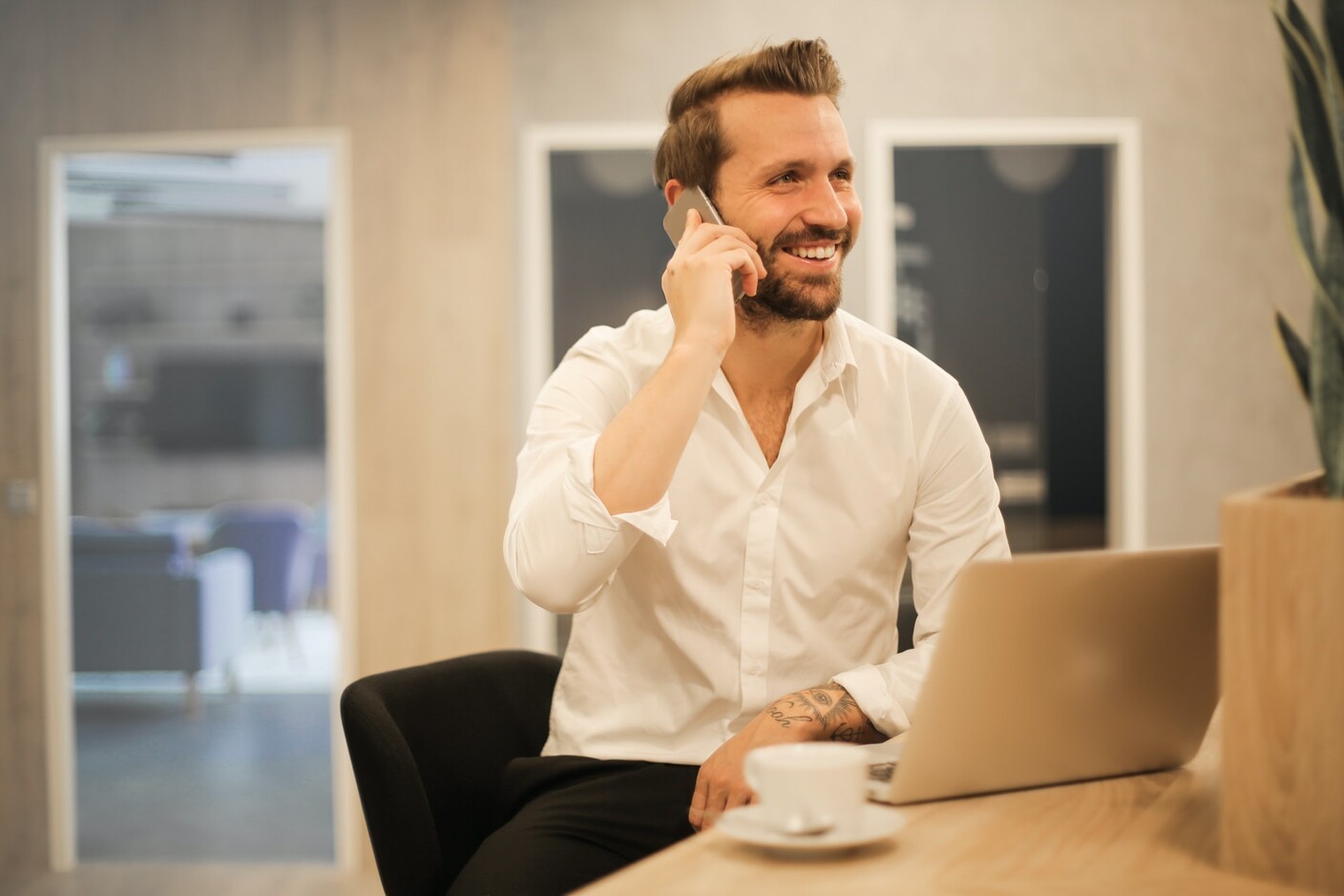
Men's Business Casual - The Ultimate Guide
If you want to master the art of business casual style, it's important to understand the basic principles and avoid common pitfalls. By following a few simple guidelines, you can create a wardrobe that is both comfortable and professional.
Quick Links
- FAQs
- Your Ultimate Wardrobe Companion
- What Does 'Business Casual' Mean For Men?
- How To Know What's Appropriate
- 2 Versions Of Business Casual
- How to Tell If Clothing Is Business (Dressy) or Casual?
- Know the Rules. Dress the Part.
- Items To Avoid
- Essential Business Casual Items
- Get the Essentials Right.
- Business Casual Shoes
- The Right Shoes, Every Time
- Accessories
- Outfit Ideas
- Outfits That Just Work.
FAQs
What is Business Casual Attire for Men?
Business casual strikes a balance between formal office wear and relaxed attire, aiming for a professional yet approachable look. The term "casual" can be misleading, often conjuring images of Hawaiian shirts and sandals, but that's far from the mark.
When dressing business casual, the key is to align with the style and sophistication expected in your industry or setting. It may seem tricky, but once you grasp the basics of blending "business" and "casual," it’s straightforward and versatile.
What is below business casual?
Well... casual.
But as you'll see in this article, business casual has a few definitions so it can get confusing.
Do I have to tuck in my shirt?
No, not always. It depends on a few factors, which will be discussed in this article:
- Your body type.
- The level of "business casual" that is required
- The type of shirt you're wearing.
Can you wear jeans for business casual?
90% of the time, yes. A fresh pair of dark, raw denim jeans in a regular or slim cut, worn with a blazer, can be considered business casual.
Is a polo shirt acceptable for business casual?
A polo shirt is usually acceptable in a business casual setting - but there are some times when it may not be - typically it depends on the industry - finance, for example, may not allow it and prefer button-down shirts, instead.
Do jeans count as business casual?
In the strict, traditional sense? No, jeans are not considered business casual. However, as the definition has loosened up over the years if the industry or event leans toward a looser definition of it, then yes, a pair of dark wash (dark blue) jeans can very much be used in a business casual outfit.
Are chino pants (AKA khaki pants) business casual?
Yes, they are almost universally considered business casual.
Is business casual with or without a tie?
Most of the time, business casual means no tie. There's some outfits where a tie can be used because there is such a thing as 'casual' ties, too. These are often knitted ties (silk or wool) that go very well with sport coats/blazers.
What is restaurant business casual?
Depends on the restaurant, but if you want to be 100% safe, no matter the restaurant's definition - button down or collared dress shirt, blazer, chino pants, dress shoes.
What shoes are considered business casual?
The standard business casual shoes are leather dress shoes:
- Oxfords
- Derbys
- Brogues
- Monkstraps
- Chukka Boots
- Dress Boots
Are sneakers business casual?
If the definition of business casual for the situation is more casual and less business, then yes, some smart low-top leather sneakers in simple colors like white, navy, gray or black, can be considered business casual.
When is business casual appropriate?
Well... when you're attending any event that requires business casual, or if you're looking to elevate hyour appearance, then the beauty of business casual is that it works in most casual situations, too.
Your Ultimate Wardrobe Companion
The Essentials App makes dressing for every occasion or dress code effortless with outfit formulas, do's and dont's, and shopping reccs - all tailored to your age, height, body type & skin tone so you'll always look amazing.
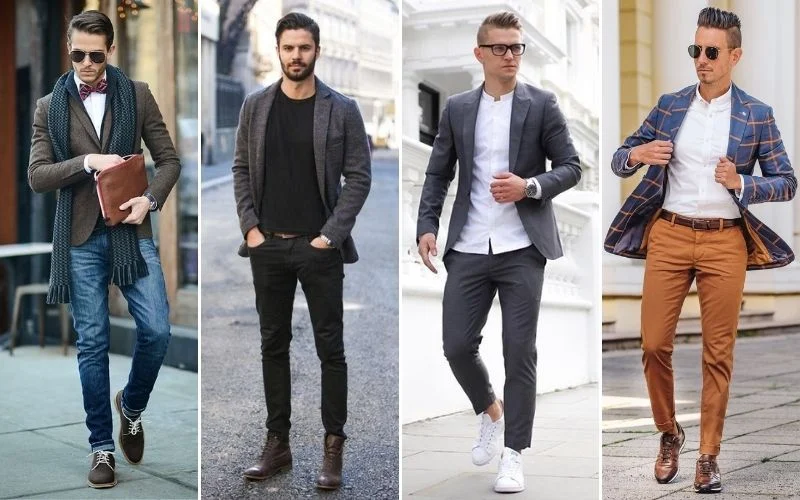
What Does 'Business Casual' Mean For Men?
Business casual (also often called "smart casual" or "dress casual") means different things to different events and industries. This trend gained momentum during the pandemic, as remote work highlighted the comfort and practicality of seasonally appropriate, relaxed clothing over traditional attire.
Business casual varies by context:
In finance or formal industries, lean toward a more polished, business-oriented look, closer to a suit.
In tech, creative fields, or labor-intensive roles, the casual side of business casual is often more acceptable.
For upscale restaurants, it's safer to dress more business than casual.
Smart casual weddings or events depend on the hosts, setting, and weather.
It may seem nuanced, but understanding the context makes it easy to nail the right look.
How To Know What's Appropriate
Here are a few strategies I use or instruct others to do to figure out what is meant by "business casual":
Look Around
You might have one of those jobs where the owners dress in t-shirts and jeans and expect people to wear ties (or vice versa).
So consider your office's style as a whole, look around, and get an average.
Are most people in sports coats and button-up shirts? Then your place probably leans on the business side.
Is everyone in jeans, boots, and sweaters? Your place probably leans casual.
Ask Someone
Many people hesitate to ask what "business casual" means in a specific context, fearing they’ll appear ignorant. In reality, asking shows respect and consideration for the request.
Here’s how to clarify expectations:
Jobs: Check the employee packet or onboarding materials—dress codes are often outlined there. If not, HR can provide clear guidance.
Events: Ask the organizers about the dress code. If their answer is unclear, request examples or specifics on what’s not acceptable.
Restaurants: Visit the restaurant’s website; dress codes are usually detailed there. If not, a quick call can clarify.
Being proactive ensures you’re well-prepared and appropriately dressed.
2 Versions Of Business Casual
There are basically two versions of business casual, which are outlined below.
If in doubt, always go to the more dressy version of what you've been told is business casual. It's always better to be slightly overdressed than underdressed.

1. Strict Business Casual
This style aligns with more conservative industries such as finance, banking, government, or formal events. There are two interpretations of "strict" business casual:
a) Very Strict
This is a full-suited look, just missing the tie. It's not that common nowadays, but it pops up enough times that it needs to be noted in case you are in one of the above industries.
Full Suit (Jacket and Pants)
Dress Shoes
No Tie
Optional: Pocket Square
b) Traditional
This is a more traditional business casual outfit, which means no suit, but you'd still wear a jacket, dress shirt, and potentially a tie (a more casual one).
Dress Shoes, Loafers, or Chukka Boots
Optional: Knit Tie or Pocket Square

2. Creative Business Casual or "Smart Casual"
The most popular type of 'business casual', this is similar to the "Traditional" version above and specifically in tech and more creative industry companies - marketing, entertainment, etc.
This typically means anything from a blazer or sports coat, button-down shirt, chino pants or dark wash jeans, and either boots, dress shoes, or high-end leather sneakers.
How to Tell If Clothing Is Business (Dressy) or Casual?
A lot of guys new to dressing well struggle with this question. Here are some quick and dirty rules to follow that'll work 98% of the time to guide you in knowing if something is too casual or dressy for a situation.
More Stuff = More Casual
Consider the difference between
a graphic t-shirt vs. a plain white Oxford shirt.
Cargo pants with tons of pockets compared to a simple, clean pair of chinos.
While they might share similar fabrics, the extra pockets, stitching, and details make the cargo pants much more casual—unsuitable for a formal meeting.
Here’s the takeaway: The simpler and more minimal the design, the more formal it appears. This principle will become even clearer when items are laid out on a formality scale later.
More Trendy = More Casual
Trendier items like athleisure sweats, Hawaiian-print shirts, or crossbody bags generally fall into the casual category. In contrast, pieces higher on the formal scale tend to feature classic, timeless designs.
While this guideline isn’t foolproof, it’s a reliable starting point for shopping and outfit planning. Remember, a great wardrobe isn’t about standout individual pieces—it’s about how each item works together to create a versatile and cohesive collection.
More Color = More Casual
A pink shirt is more casual than a crisp white shirt. A light blue suit is more casual than a dark navy suit.
When it comes to formality, neutral colors (navy, white, black, grey, olive, camel), come off more professional and formal.
Know the Rules. Dress the Part.
The Essentials App breaks down exactly what to wear—and what to avoid—while tailoring your look to fit your body type and personal style.

Items To Avoid
So, before we get into what items you need as part of your business casual wardrobe, let's elaborate on certain pieces that do not fit within this particular dress code:
Dressier Items
Thought it was stated earlier that you should lean more toward business than casual, there are definitely a few items that are way too dressy.
First of all, no suits (unless it's a 'strict business casual' dress code).
These are just too formal, and the same could be said for dress shirts and neckties.Though blazers are indeed a business casual staple, make sure you are going for a blazer here and not a suit jacket.
The reason why is that suit jackets can look particularly boxy when paired with other non-formal items, particularly around the shoulders.
Though t-shirts can look great when paired with dressier items, you should avoid wearing them, as, when it comes to business casual environments, they’re just too relaxed-looking.
Casual Bottoms
This should go without saying but:
No joggers
No light-wash jeans
No shorts
Casual Footwear
Shoe-wise, you’ll want to steer clear of the more casual styles, like high-tops, colorful low-tops, running shoes, sandals, and boat shoes.
Bad Accessories
This is where a lot of guys screw up, so pay attention to your accessories. Certain items, like casual backpacks, gaudy jewelry, and novelty cufflinks, will sink your overall look.
Essential Business Casual Items
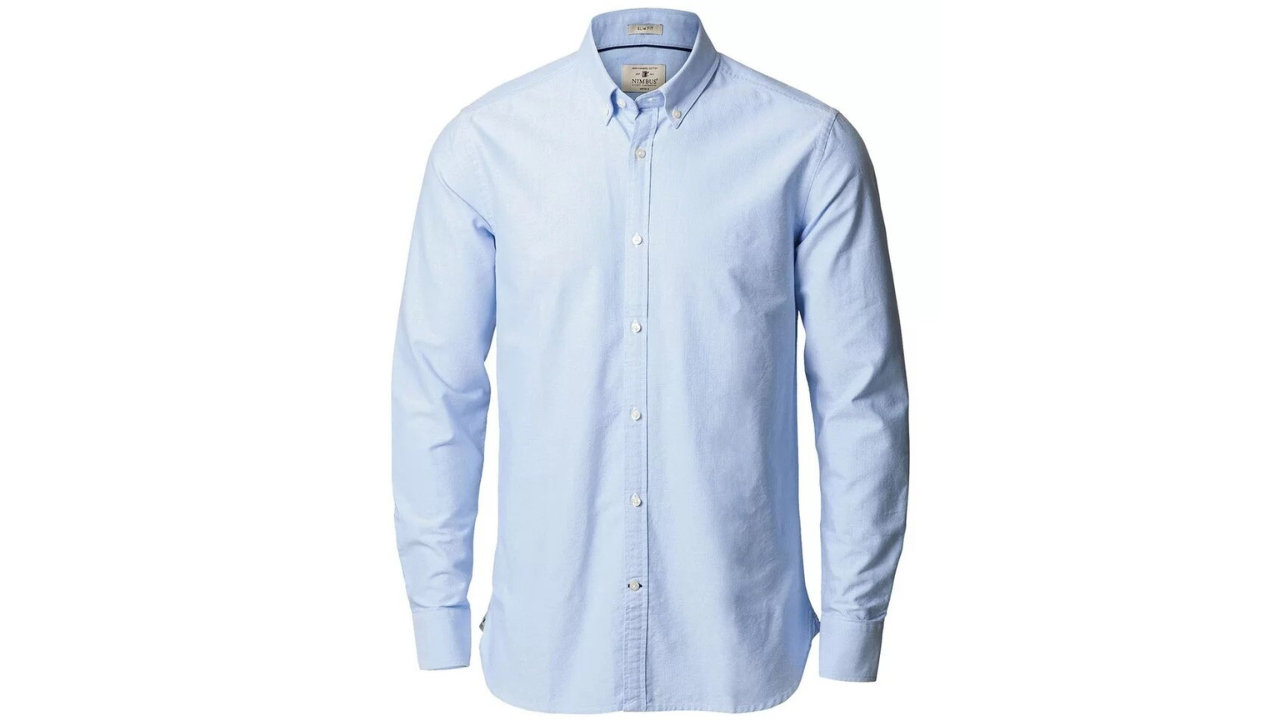
Oxford Shirt
Stylish, smart, and versatile, Oxford shirts are usually made from a thicker fabric which gives them a more relaxed appearance than thinner dress shirts.
For a more professional look, tuck your Oxford into your pants but feel free to leave yours untucked if you’re going for a more casual vibe.
Colors & Quantities
Get one in white and one in light blue before moving on to other colors.
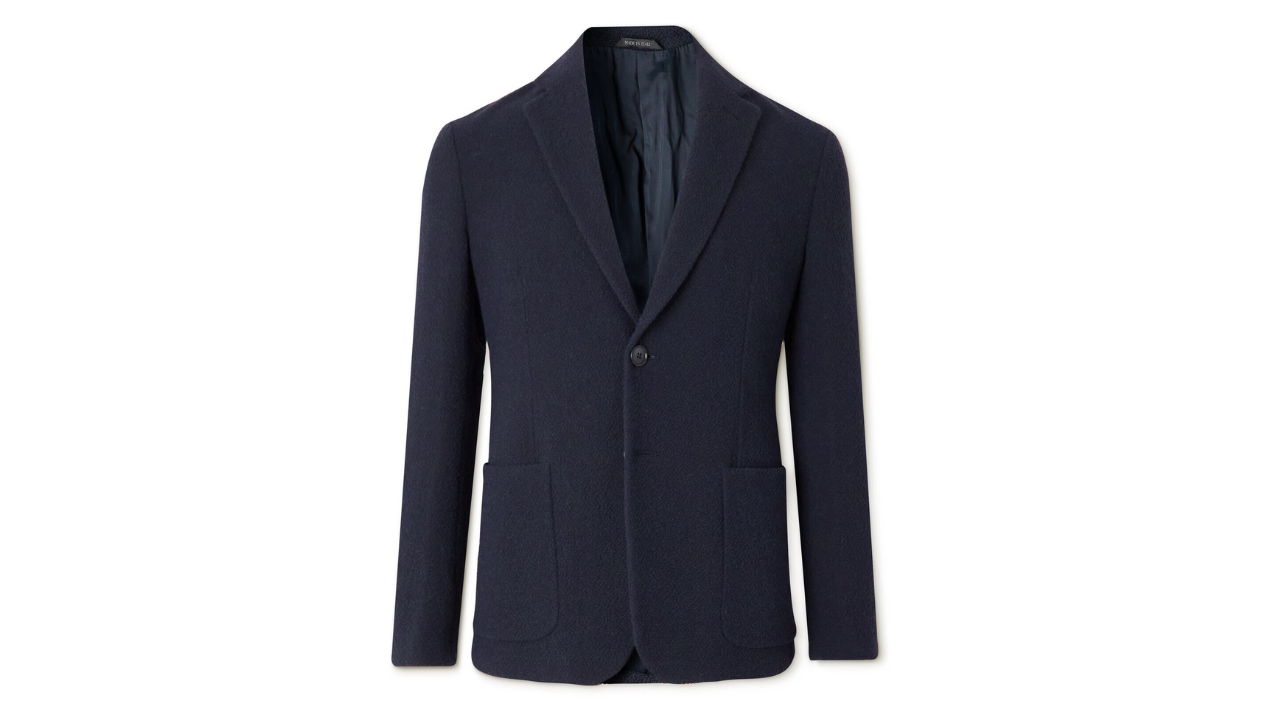
Blazer/Sports Coat
As I mentioned earlier, a blazer or sports coat is also an essential business casual item that will allow you to elevate your outfits with ease.
Colors
Go for one in a solid color (like charcoal or navy), as this will be easier to layer and pair with different shirt-and-pants combos.

Sweaters
Speaking of layering, you’re definitely going to want some items to throw over your shirts when it starts to get chilly during the fall and winter months. I’d recommend picking up some v-neck and crew neck sweaters in fabrics like merino wool and cashmere
Colors
Dark neutral colors like black, navy, and navy are timeless sweater options and always look good when layered (v-necks only!) over white or light blue Oxford shirts.
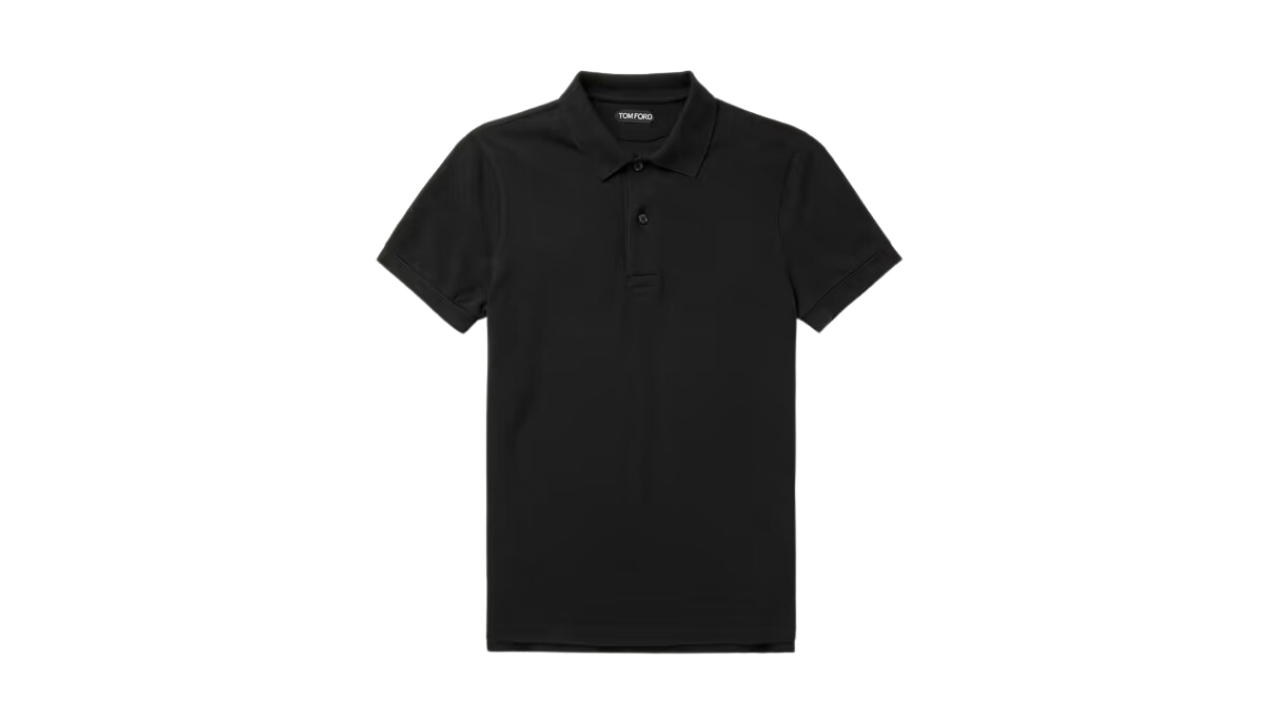
Polo Shirt
If you’re looking for something smarter than a crewneck tee but lighter than an Oxford long-sleeve shirt then you really can’t go wrong with a good polo. These have a distinct preppy vibe that just screams ‘smart casual’ and they can be paired with everything from dress pants to dark-wash jeans.
Also, if you’re wearing a belt (that obviously matches your shoes, right?) then don’t be afraid to tuck that polo in to earn some extra style points.
Colors
Stick with the classics; black and navy.
Get the Essentials Right.
Not sure which pieces belong in your wardrobe? The Essentials App highlights key staples—blazers, chinos, shirts, and shoes—chosen to complement your age, height, build, & skin tone.
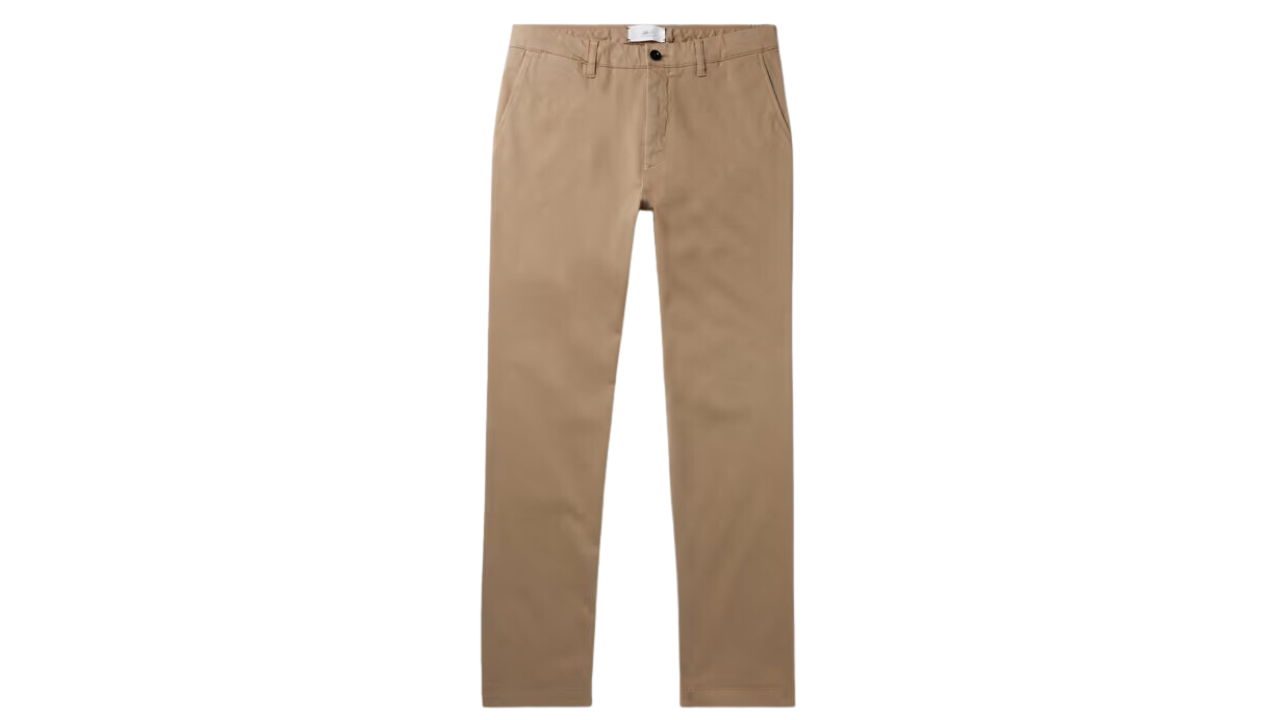
Chinos
Not too dressy, not relaxed, chinos are the perfect smart-casual pant. They allow for a clean and put-together appearance and go with so many different items.
Colors & Quantities
Stick to neutral shades like sand, navy, olive, and gray, for optimum versatility and pairing options.

Dark-Wash Jeans
If you’re in a more relaxed office environment and you really want to put the ‘casual’ in business casual, then you are permitted to swap out the chinos for some classic well-fitting jeans.
Colors
Stick with a dark-wash (dark indigo) color. Anything lighter is too casual and black or gray jeans will just look off.

Wool Trousers
Wool trousers are a classic smart-casual item and are a nice alternative to your go-to chinos or denim. Just try and save these for fall and winter, as they can look (and feel) a bit heavy during the warm-weather months.
Colors
Charcoal is a classic shade for wool trousers but you can always go with navy if you're looking for a smarter alternative to your dark-wash jeans.

Business Casual Shoes
OK, so at this stage, you’re probably asking ‘But what about my footwear?’ Well, the short answer is that most types of dress shoes are appropriate for a business-casual dress code.
However, before you go out and buy some square-toed leather shoes that look boxier than the box they came in, let’s get a bit more specific.

Oxford Dress Shoes
This is a classic dress shoe that never fails to look smart when paired with the items listed above. If the aesthetic of leather is just too dressy for you, then you could always go for a suede pair instead.
Colors
If your outfit features black as its predominant color (in your sweater, pants, or both), then go with black Oxford shoes. Otherwise, stick with medium brown.

Loafers
If dress shoes aren’t your thing, then consider going for a pair of loafers instead. Provided that you pair them with no-show socks, these timeless slip-on shoes are perfect for the majority of business casual outfits.
Colors
We recommend a nice chocolatey penny loafer, but you could always go for a more relaxed suede driving moccasin if that’s more your thing.
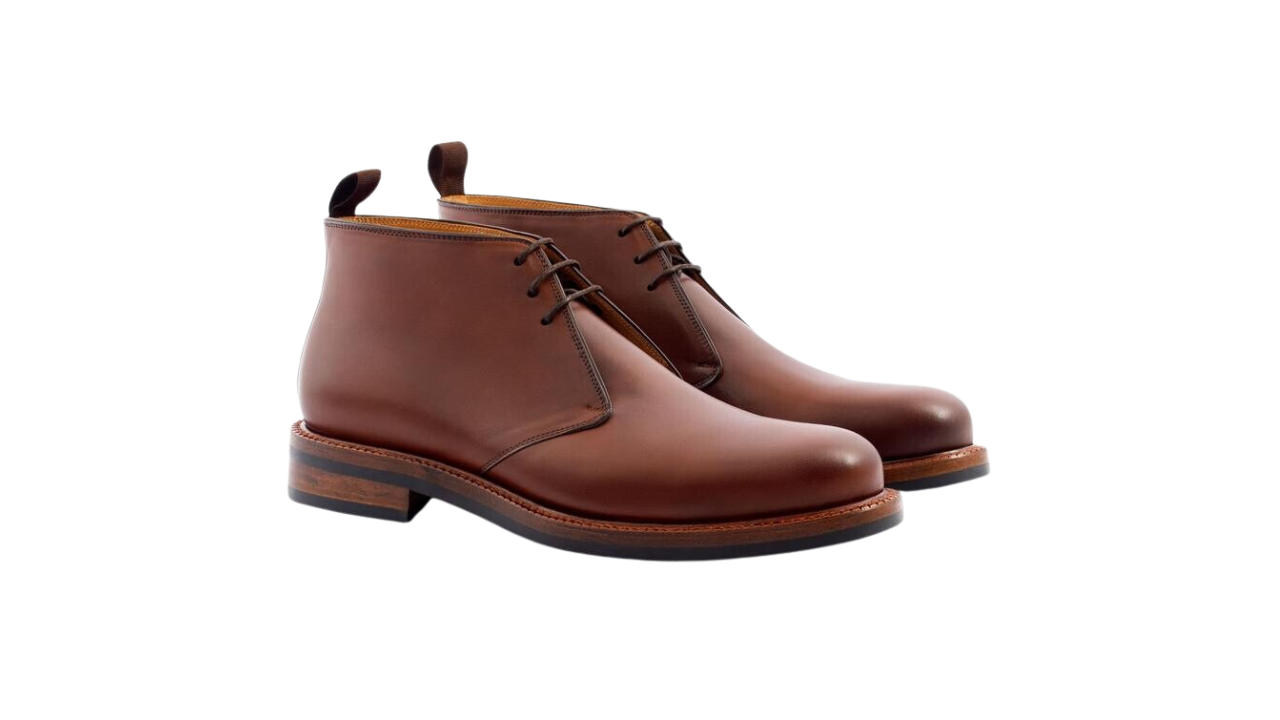
Chukka Boots
If you’re looking for footwear that’s a bit more rugged and manly but still office-appropriate, then you should consider a pair of leather chukka boots. This stylish boot goes with all types of pants of business-casual pants, from chinos to jeans, and is definitely worth investing in.
Colors
Go for medium or dark brown, as these are the most versatile colors.
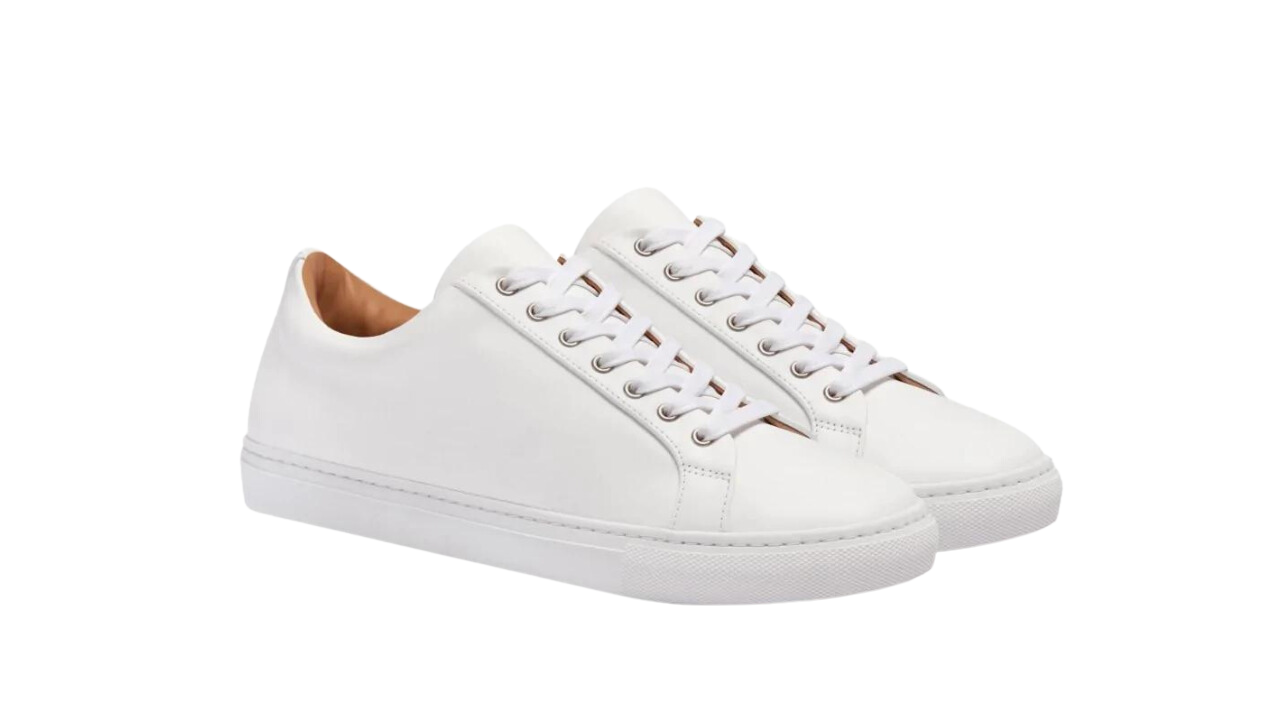
Low-Top Sneakers
So, sneakers are permissible but, as they are definitely a more casual item, they need to be paired with smarter items for the overall outfit to work. This obviously won't work in a very traditional business casual outfit, so don't think it works across the board.
Colors
You’ll want to go fora minimal, white, preferably leather version. Also, these will need to be kept immaculately clean.
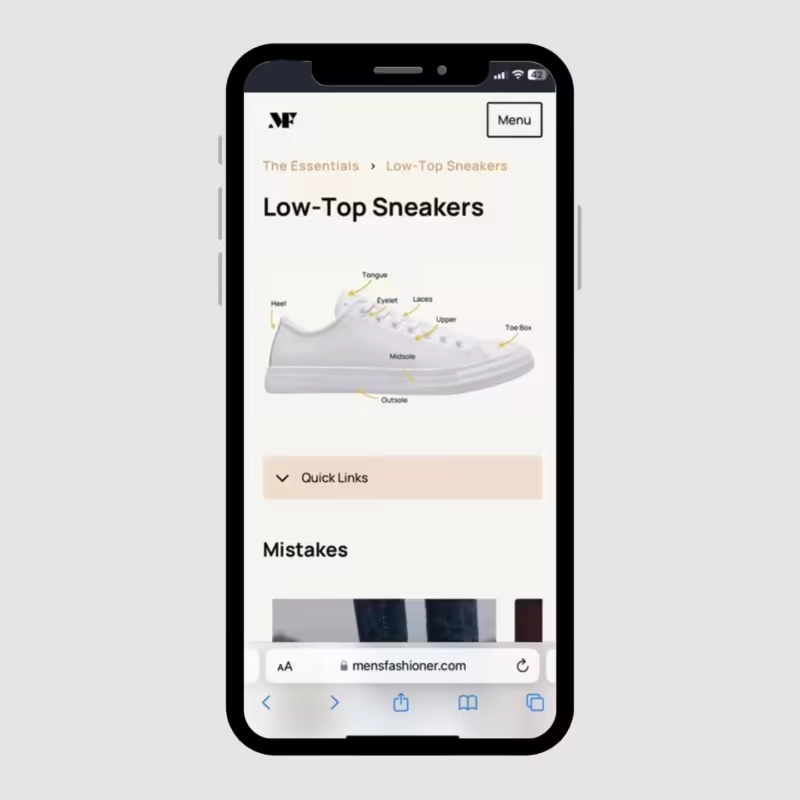
The Right Shoes, Every Time
From dress shoes to sneakers, The Essentials App helps you choose the perfect footwear for any outfit.

Accessories
So, when it comes to the business casual dress code, your accessories really shouldn’t differ from any other dress code in that less will always be more.
You really want to nail the fundamentals and invest in minimal and versatile items that will complement your overall aesthetic rather than distract from it.
Everything else, like pocket squares, neckties, cufflinks, boutonnieres, etc, is just overkill and not necessary.

Watch
The wristwatch is the ultimate men’s accessory, and when it comes to which kind of watch to go for, you honestly have a lot of room to play with.
We recommend choosing one that reflects your own personal style, but try not to go too colorful or cartoony.
Alternatively, you could always go for a nice metal cuff, provided it has a stylish minimal design.
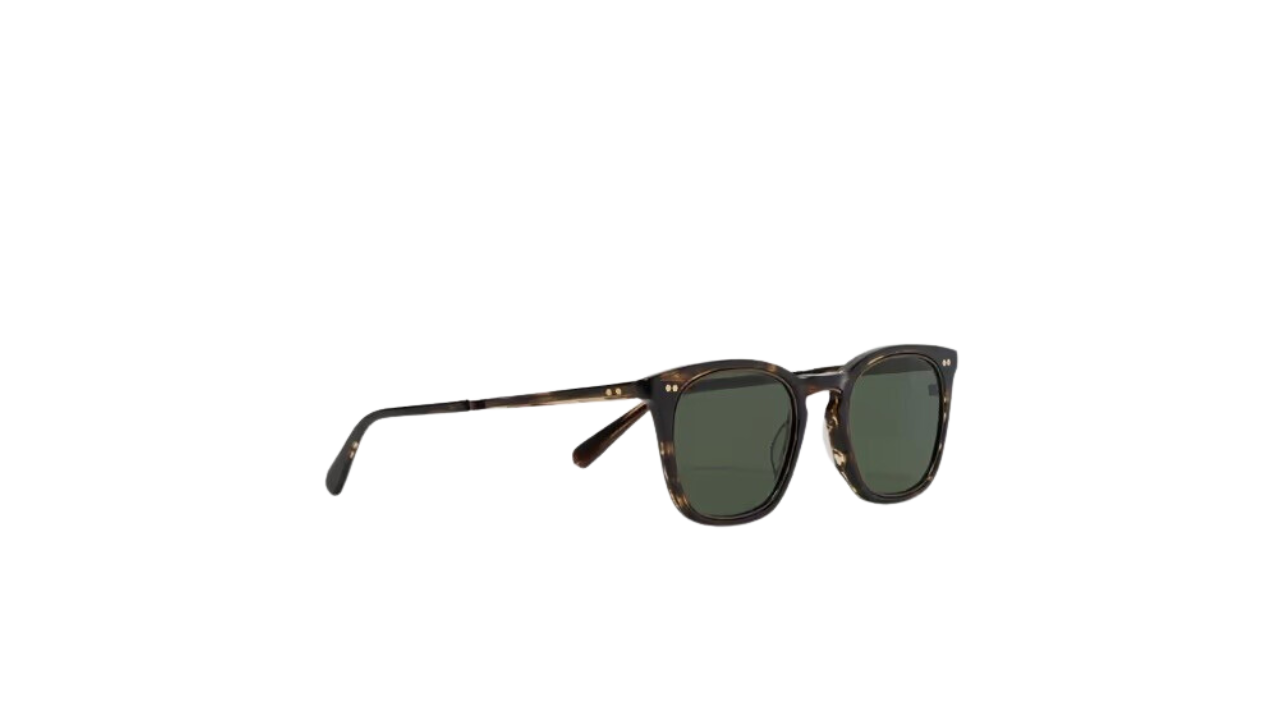
Sunglasses
Your sunglasses should be a classic frame that compliments your face in a black, brown, or tortoiseshell shade.
Outfit Ideas
Outfit 1

Navy Sports Coat
White Oxford Shirt
Tan Chinos
Brown Oxford Dress Shoes
This outfit formula never fails to impress. If you get too hot, feel free to remove the blazer and if you want to dress it down, you could always swap out the dress shoes for a pair of shiny white low-top sneakers.
Outfits That Just Work.
The Essentials App delivers age-appropriate business casual combinations tailored to your height, build, and skin tone—so you always look on-point, whether at the office or after-hours.
Outfit 2

Charcoal Sports Coat
Navy V-Neck Sweater
White Oxford Shirt
Dark-Wash Jeans
Brown Dress Shoes
We've got some expert-level business-casual layering going on here! This combo would also work if you wanted to remove the V-neck sweater and make sure that you're going for a brown belt to match the shoes.
Outfit 3

White Oxford Dress Shirt
Navy Wool Trousers
Brown Loafers
Sometimes less is definitely more, as shown in this simple and stylish outfit combination. If you wanted to dress this up even further, you could always layer a charcoal blazer or sports coat on top.

